Management Accounting Report: Performance and Decision Making
VerifiedAdded on 2022/12/19
|13
|2628
|238
Report
AI Summary
This report analyzes management accounting techniques, including activity-based costing, budgeting, and balanced scorecards, to evaluate organizational performance and financial feasibility. The report begins with an introduction to management accounting and its role in decision-making, followed by an analysis of activity-based costing, calculations of activity costs, and recommendations for capacity utilization. The second section presents an income statement analysis, calculations of contribution margins, break-even points, and sales levels. The report then explores sales, production, and component usage budgets, offering recommendations for financial feasibility. Finally, the report discusses the balanced scorecard as a performance management tool, outlining its perspectives, objectives, and measures for the University of Malaysia. The report emphasizes the importance of cost management, strategic planning, and effective decision-making for improved organizational outcomes.
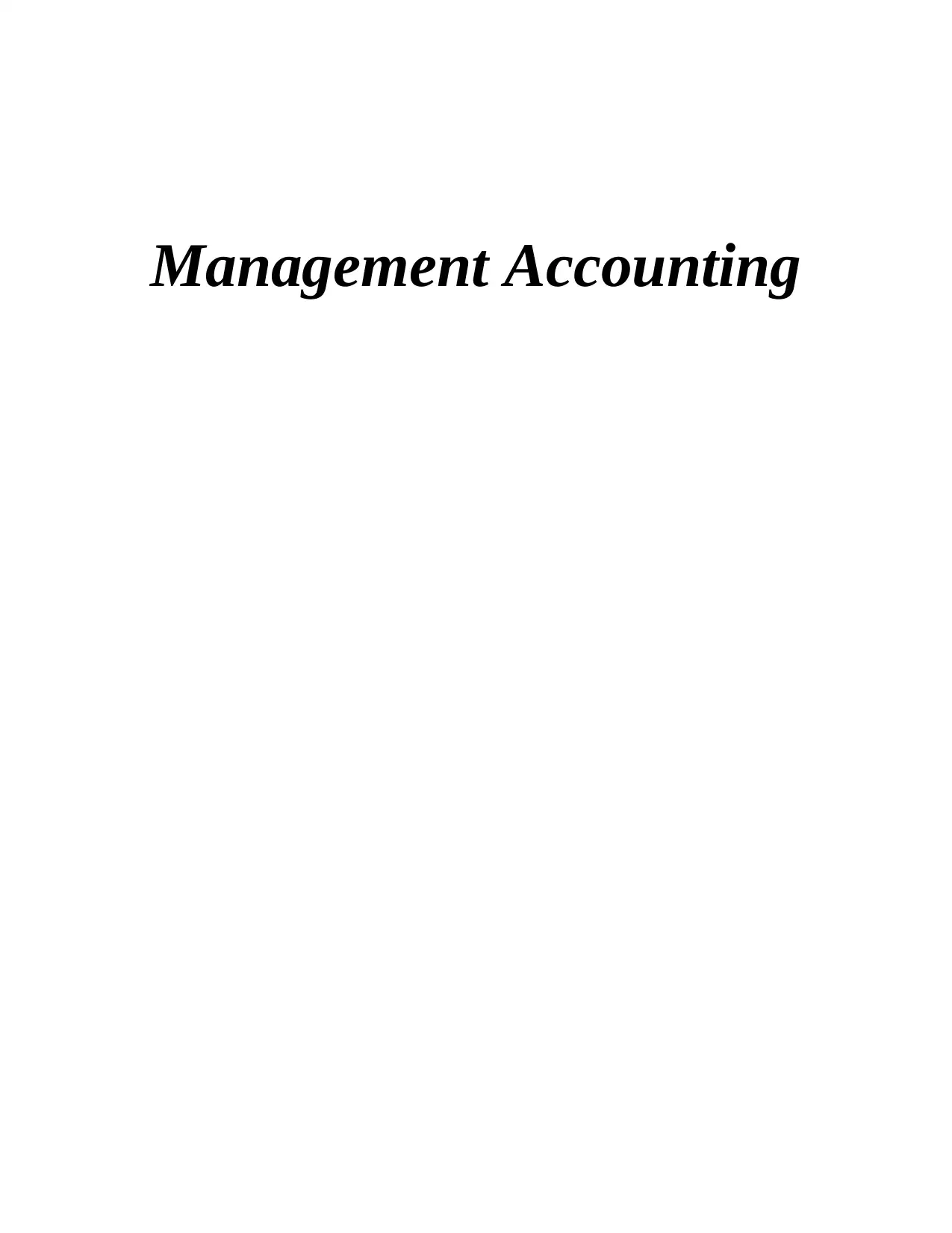
Management Accounting
Paraphrase This Document
Need a fresh take? Get an instant paraphrase of this document with our AI Paraphraser
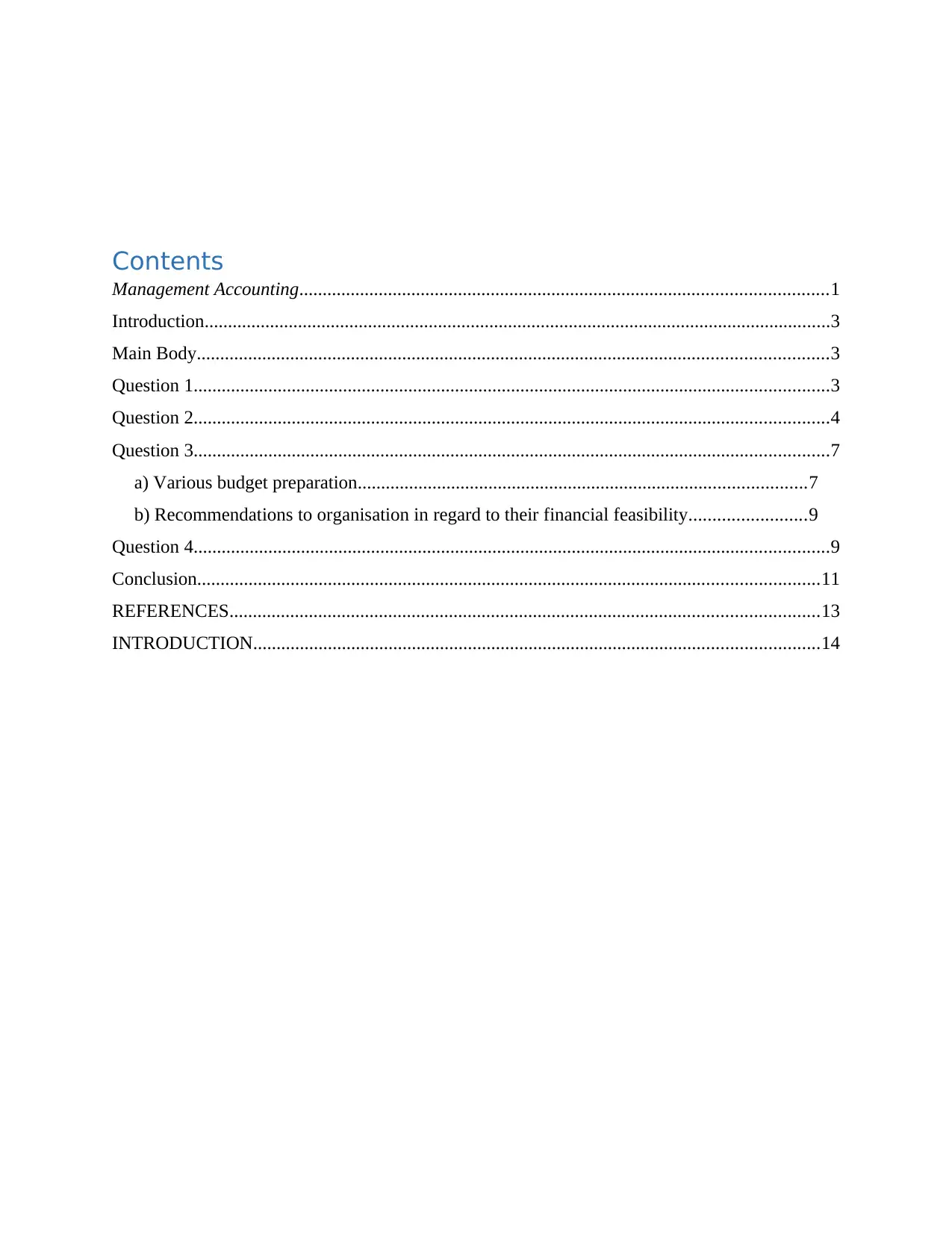
Contents
Management Accounting.................................................................................................................1
Introduction......................................................................................................................................3
Main Body.......................................................................................................................................3
Question 1........................................................................................................................................3
Question 2........................................................................................................................................4
Question 3........................................................................................................................................7
a) Various budget preparation................................................................................................7
b) Recommendations to organisation in regard to their financial feasibility.........................9
Question 4........................................................................................................................................9
Conclusion.....................................................................................................................................11
REFERENCES..............................................................................................................................13
INTRODUCTION.........................................................................................................................14
Management Accounting.................................................................................................................1
Introduction......................................................................................................................................3
Main Body.......................................................................................................................................3
Question 1........................................................................................................................................3
Question 2........................................................................................................................................4
Question 3........................................................................................................................................7
a) Various budget preparation................................................................................................7
b) Recommendations to organisation in regard to their financial feasibility.........................9
Question 4........................................................................................................................................9
Conclusion.....................................................................................................................................11
REFERENCES..............................................................................................................................13
INTRODUCTION.........................................................................................................................14
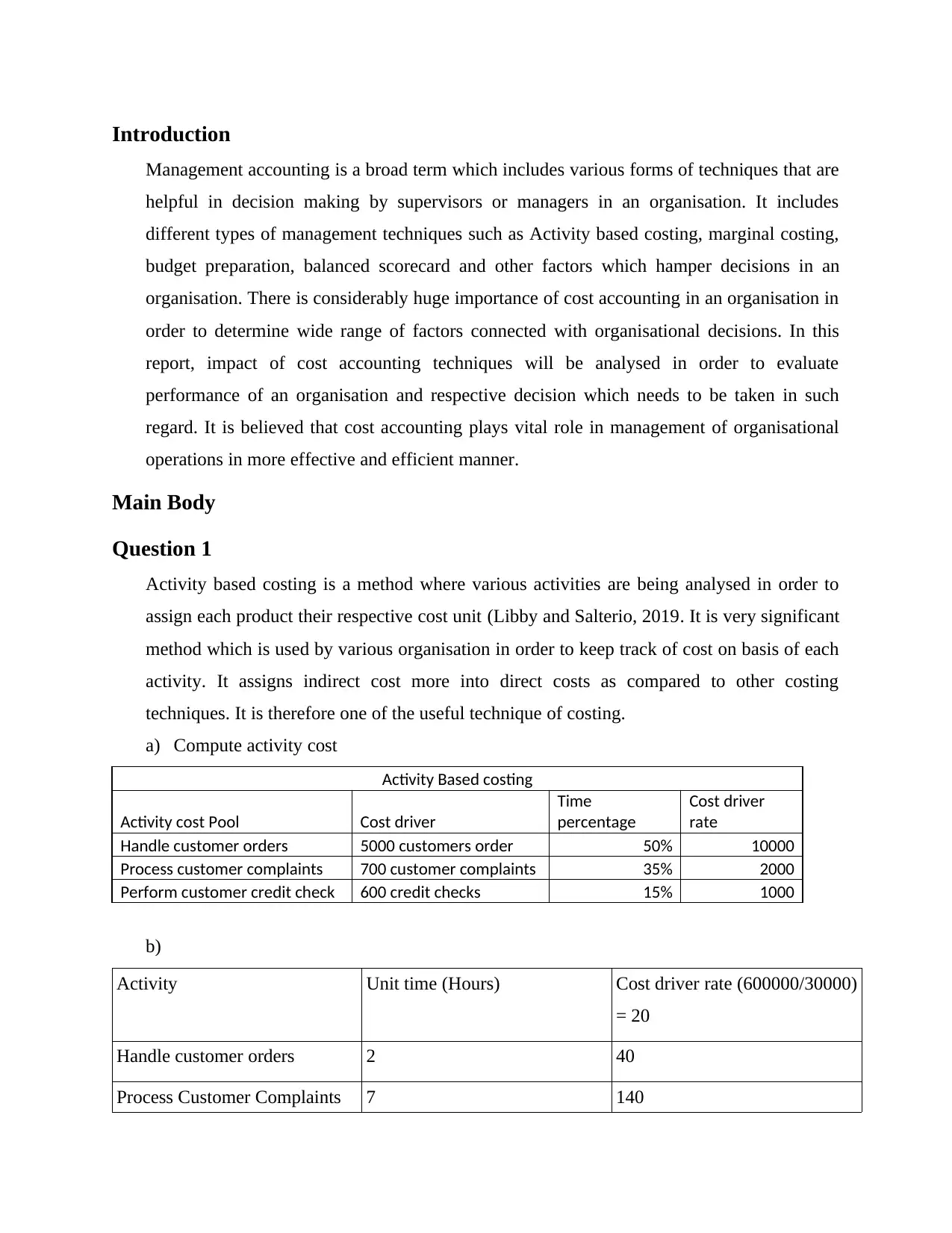
Introduction
Management accounting is a broad term which includes various forms of techniques that are
helpful in decision making by supervisors or managers in an organisation. It includes
different types of management techniques such as Activity based costing, marginal costing,
budget preparation, balanced scorecard and other factors which hamper decisions in an
organisation. There is considerably huge importance of cost accounting in an organisation in
order to determine wide range of factors connected with organisational decisions. In this
report, impact of cost accounting techniques will be analysed in order to evaluate
performance of an organisation and respective decision which needs to be taken in such
regard. It is believed that cost accounting plays vital role in management of organisational
operations in more effective and efficient manner.
Main Body
Question 1
Activity based costing is a method where various activities are being analysed in order to
assign each product their respective cost unit (Libby and Salterio, 2019. It is very significant
method which is used by various organisation in order to keep track of cost on basis of each
activity. It assigns indirect cost more into direct costs as compared to other costing
techniques. It is therefore one of the useful technique of costing.
a) Compute activity cost
Activity Based costing
Activity cost Pool Cost driver
Time
percentage
Cost driver
rate
Handle customer orders 5000 customers order 50% 10000
Process customer complaints 700 customer complaints 35% 2000
Perform customer credit check 600 credit checks 15% 1000
b)
Activity Unit time (Hours) Cost driver rate (600000/30000)
= 20
Handle customer orders 2 40
Process Customer Complaints 7 140
Management accounting is a broad term which includes various forms of techniques that are
helpful in decision making by supervisors or managers in an organisation. It includes
different types of management techniques such as Activity based costing, marginal costing,
budget preparation, balanced scorecard and other factors which hamper decisions in an
organisation. There is considerably huge importance of cost accounting in an organisation in
order to determine wide range of factors connected with organisational decisions. In this
report, impact of cost accounting techniques will be analysed in order to evaluate
performance of an organisation and respective decision which needs to be taken in such
regard. It is believed that cost accounting plays vital role in management of organisational
operations in more effective and efficient manner.
Main Body
Question 1
Activity based costing is a method where various activities are being analysed in order to
assign each product their respective cost unit (Libby and Salterio, 2019. It is very significant
method which is used by various organisation in order to keep track of cost on basis of each
activity. It assigns indirect cost more into direct costs as compared to other costing
techniques. It is therefore one of the useful technique of costing.
a) Compute activity cost
Activity Based costing
Activity cost Pool Cost driver
Time
percentage
Cost driver
rate
Handle customer orders 5000 customers order 50% 10000
Process customer complaints 700 customer complaints 35% 2000
Perform customer credit check 600 credit checks 15% 1000
b)
Activity Unit time (Hours) Cost driver rate (600000/30000)
= 20
Handle customer orders 2 40
Process Customer Complaints 7 140
⊘ This is a preview!⊘
Do you want full access?
Subscribe today to unlock all pages.

Trusted by 1+ million students worldwide
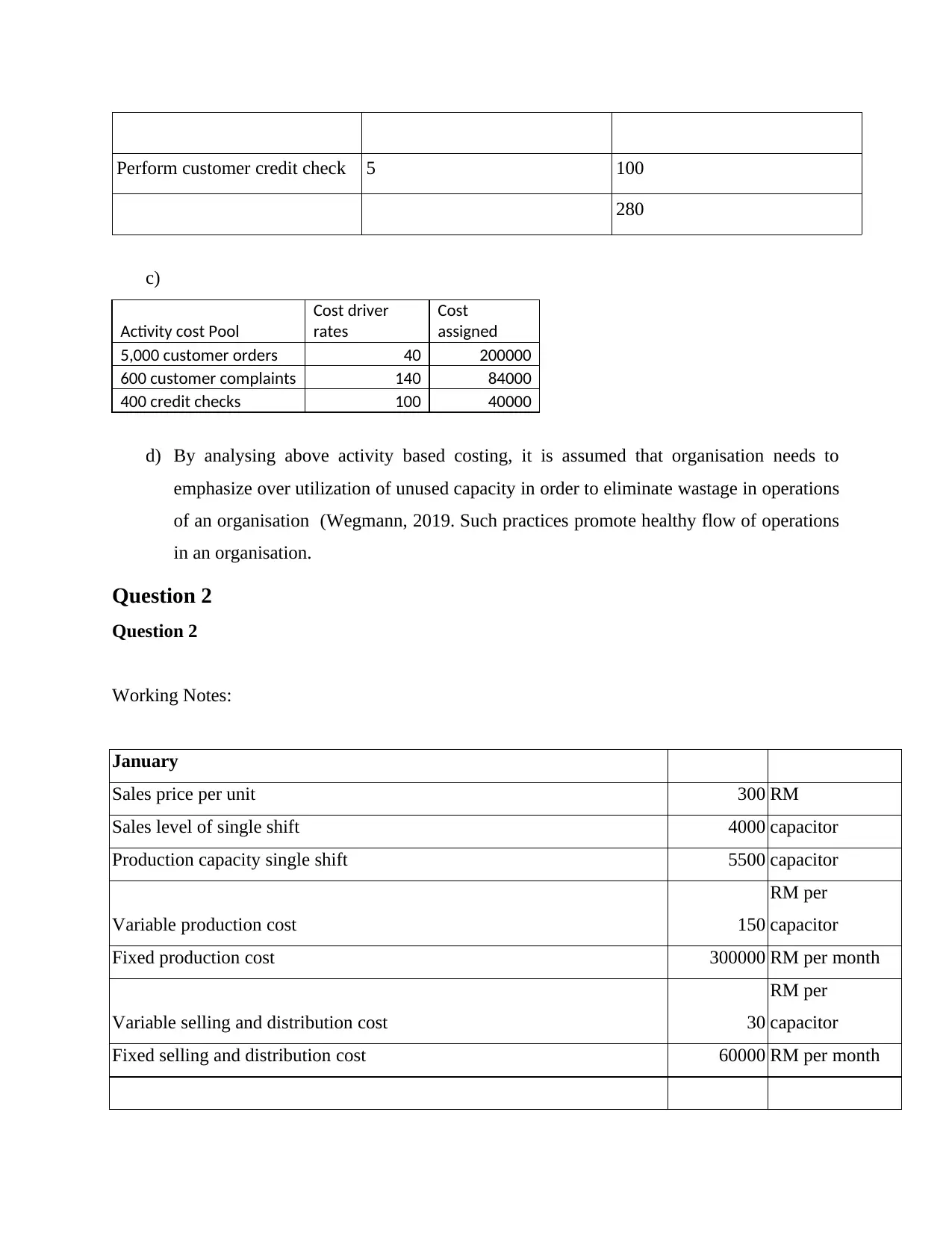
Perform customer credit check 5 100
280
c)
Activity cost Pool
Cost driver
rates
Cost
assigned
5,000 customer orders 40 200000
600 customer complaints 140 84000
400 credit checks 100 40000
d) By analysing above activity based costing, it is assumed that organisation needs to
emphasize over utilization of unused capacity in order to eliminate wastage in operations
of an organisation (Wegmann, 2019. Such practices promote healthy flow of operations
in an organisation.
Question 2
Question 2
Working Notes:
January
Sales price per unit 300 RM
Sales level of single shift 4000 capacitor
Production capacity single shift 5500 capacitor
Variable production cost 150
RM per
capacitor
Fixed production cost 300000 RM per month
Variable selling and distribution cost 30
RM per
capacitor
Fixed selling and distribution cost 60000 RM per month
280
c)
Activity cost Pool
Cost driver
rates
Cost
assigned
5,000 customer orders 40 200000
600 customer complaints 140 84000
400 credit checks 100 40000
d) By analysing above activity based costing, it is assumed that organisation needs to
emphasize over utilization of unused capacity in order to eliminate wastage in operations
of an organisation (Wegmann, 2019. Such practices promote healthy flow of operations
in an organisation.
Question 2
Question 2
Working Notes:
January
Sales price per unit 300 RM
Sales level of single shift 4000 capacitor
Production capacity single shift 5500 capacitor
Variable production cost 150
RM per
capacitor
Fixed production cost 300000 RM per month
Variable selling and distribution cost 30
RM per
capacitor
Fixed selling and distribution cost 60000 RM per month
Paraphrase This Document
Need a fresh take? Get an instant paraphrase of this document with our AI Paraphraser
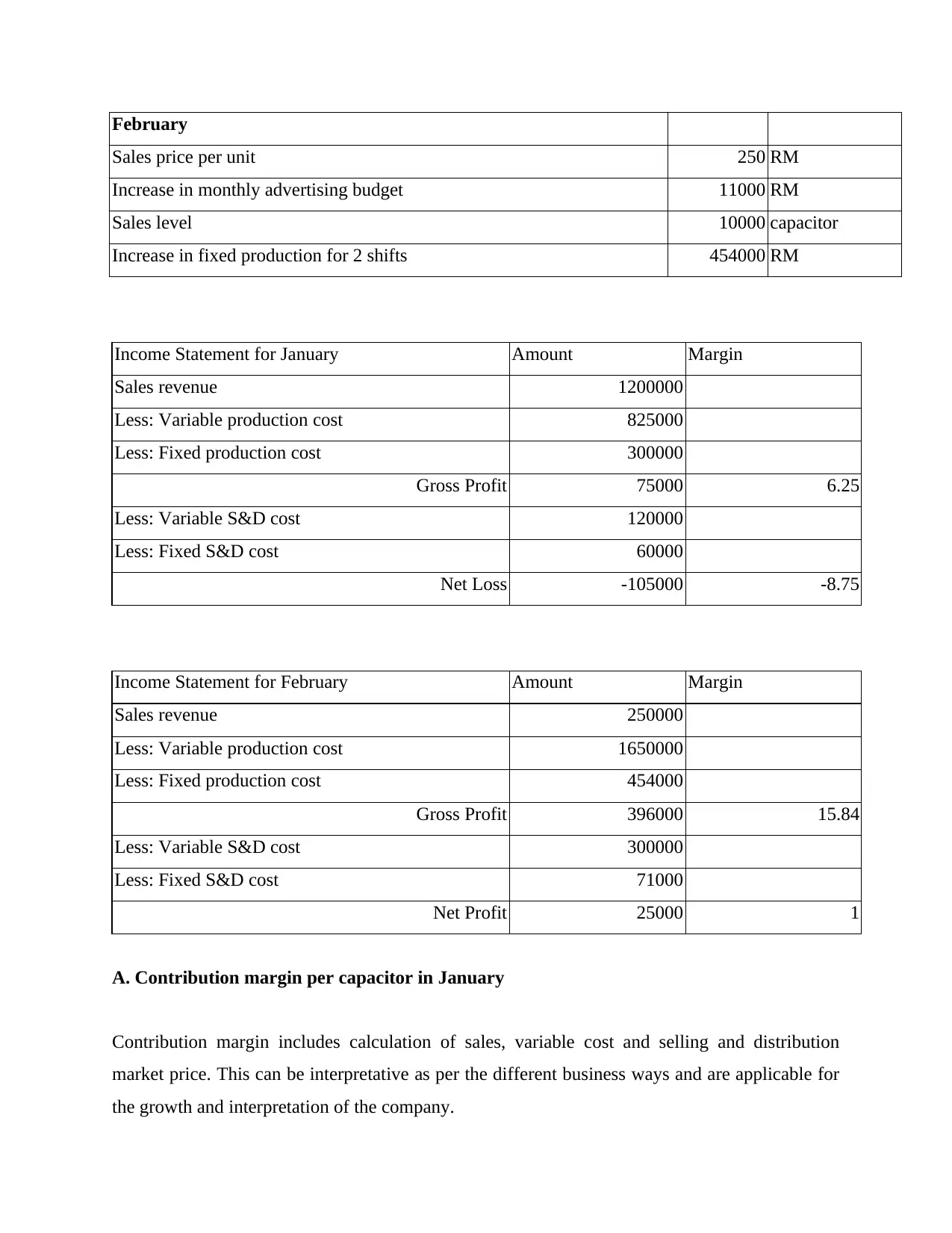
February
Sales price per unit 250 RM
Increase in monthly advertising budget 11000 RM
Sales level 10000 capacitor
Increase in fixed production for 2 shifts 454000 RM
Income Statement for January Amount Margin
Sales revenue 1200000
Less: Variable production cost 825000
Less: Fixed production cost 300000
Gross Profit 75000 6.25
Less: Variable S&D cost 120000
Less: Fixed S&D cost 60000
Net Loss -105000 -8.75
Income Statement for February Amount Margin
Sales revenue 250000
Less: Variable production cost 1650000
Less: Fixed production cost 454000
Gross Profit 396000 15.84
Less: Variable S&D cost 300000
Less: Fixed S&D cost 71000
Net Profit 25000 1
A. Contribution margin per capacitor in January
Contribution margin includes calculation of sales, variable cost and selling and distribution
market price. This can be interpretative as per the different business ways and are applicable for
the growth and interpretation of the company.
Sales price per unit 250 RM
Increase in monthly advertising budget 11000 RM
Sales level 10000 capacitor
Increase in fixed production for 2 shifts 454000 RM
Income Statement for January Amount Margin
Sales revenue 1200000
Less: Variable production cost 825000
Less: Fixed production cost 300000
Gross Profit 75000 6.25
Less: Variable S&D cost 120000
Less: Fixed S&D cost 60000
Net Loss -105000 -8.75
Income Statement for February Amount Margin
Sales revenue 250000
Less: Variable production cost 1650000
Less: Fixed production cost 454000
Gross Profit 396000 15.84
Less: Variable S&D cost 300000
Less: Fixed S&D cost 71000
Net Profit 25000 1
A. Contribution margin per capacitor in January
Contribution margin includes calculation of sales, variable cost and selling and distribution
market price. This can be interpretative as per the different business ways and are applicable for
the growth and interpretation of the company.
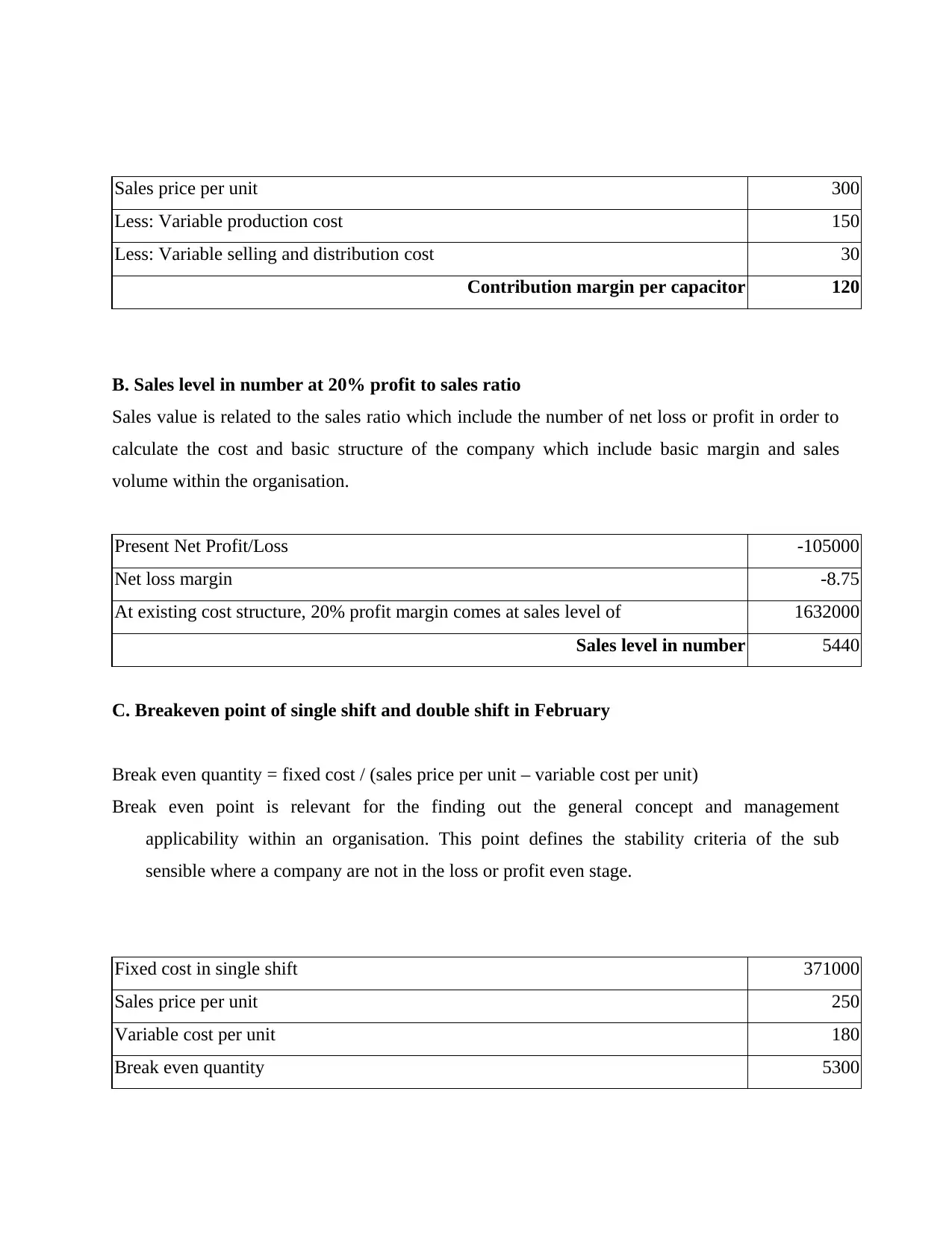
Sales price per unit 300
Less: Variable production cost 150
Less: Variable selling and distribution cost 30
Contribution margin per capacitor 120
B. Sales level in number at 20% profit to sales ratio
Sales value is related to the sales ratio which include the number of net loss or profit in order to
calculate the cost and basic structure of the company which include basic margin and sales
volume within the organisation.
Present Net Profit/Loss -105000
Net loss margin -8.75
At existing cost structure, 20% profit margin comes at sales level of 1632000
Sales level in number 5440
C. Breakeven point of single shift and double shift in February
Break even quantity = fixed cost / (sales price per unit – variable cost per unit)
Break even point is relevant for the finding out the general concept and management
applicability within an organisation. This point defines the stability criteria of the sub
sensible where a company are not in the loss or profit even stage.
Fixed cost in single shift 371000
Sales price per unit 250
Variable cost per unit 180
Break even quantity 5300
Less: Variable production cost 150
Less: Variable selling and distribution cost 30
Contribution margin per capacitor 120
B. Sales level in number at 20% profit to sales ratio
Sales value is related to the sales ratio which include the number of net loss or profit in order to
calculate the cost and basic structure of the company which include basic margin and sales
volume within the organisation.
Present Net Profit/Loss -105000
Net loss margin -8.75
At existing cost structure, 20% profit margin comes at sales level of 1632000
Sales level in number 5440
C. Breakeven point of single shift and double shift in February
Break even quantity = fixed cost / (sales price per unit – variable cost per unit)
Break even point is relevant for the finding out the general concept and management
applicability within an organisation. This point defines the stability criteria of the sub
sensible where a company are not in the loss or profit even stage.
Fixed cost in single shift 371000
Sales price per unit 250
Variable cost per unit 180
Break even quantity 5300
⊘ This is a preview!⊘
Do you want full access?
Subscribe today to unlock all pages.

Trusted by 1+ million students worldwide
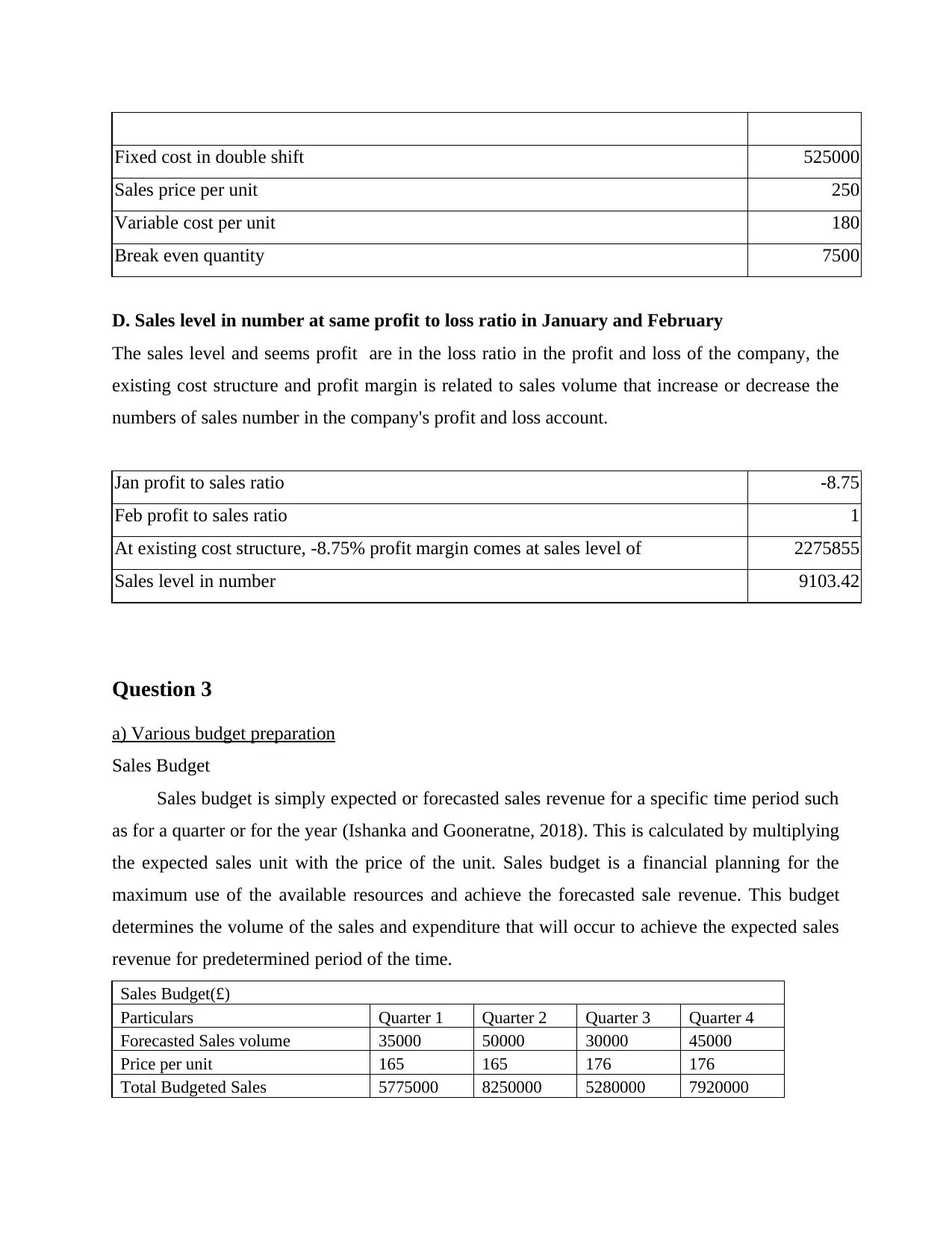
Fixed cost in double shift 525000
Sales price per unit 250
Variable cost per unit 180
Break even quantity 7500
D. Sales level in number at same profit to loss ratio in January and February
The sales level and seems profit are in the loss ratio in the profit and loss of the company, the
existing cost structure and profit margin is related to sales volume that increase or decrease the
numbers of sales number in the company's profit and loss account.
Jan profit to sales ratio -8.75
Feb profit to sales ratio 1
At existing cost structure, -8.75% profit margin comes at sales level of 2275855
Sales level in number 9103.42
Question 3
a) Various budget preparation
Sales Budget
Sales budget is simply expected or forecasted sales revenue for a specific time period such
as for a quarter or for the year (Ishanka and Gooneratne, 2018). This is calculated by multiplying
the expected sales unit with the price of the unit. Sales budget is a financial planning for the
maximum use of the available resources and achieve the forecasted sale revenue. This budget
determines the volume of the sales and expenditure that will occur to achieve the expected sales
revenue for predetermined period of the time.
Sales Budget(£)
Particulars Quarter 1 Quarter 2 Quarter 3 Quarter 4
Forecasted Sales volume 35000 50000 30000 45000
Price per unit 165 165 176 176
Total Budgeted Sales 5775000 8250000 5280000 7920000
Sales price per unit 250
Variable cost per unit 180
Break even quantity 7500
D. Sales level in number at same profit to loss ratio in January and February
The sales level and seems profit are in the loss ratio in the profit and loss of the company, the
existing cost structure and profit margin is related to sales volume that increase or decrease the
numbers of sales number in the company's profit and loss account.
Jan profit to sales ratio -8.75
Feb profit to sales ratio 1
At existing cost structure, -8.75% profit margin comes at sales level of 2275855
Sales level in number 9103.42
Question 3
a) Various budget preparation
Sales Budget
Sales budget is simply expected or forecasted sales revenue for a specific time period such
as for a quarter or for the year (Ishanka and Gooneratne, 2018). This is calculated by multiplying
the expected sales unit with the price of the unit. Sales budget is a financial planning for the
maximum use of the available resources and achieve the forecasted sale revenue. This budget
determines the volume of the sales and expenditure that will occur to achieve the expected sales
revenue for predetermined period of the time.
Sales Budget(£)
Particulars Quarter 1 Quarter 2 Quarter 3 Quarter 4
Forecasted Sales volume 35000 50000 30000 45000
Price per unit 165 165 176 176
Total Budgeted Sales 5775000 8250000 5280000 7920000
Paraphrase This Document
Need a fresh take? Get an instant paraphrase of this document with our AI Paraphraser
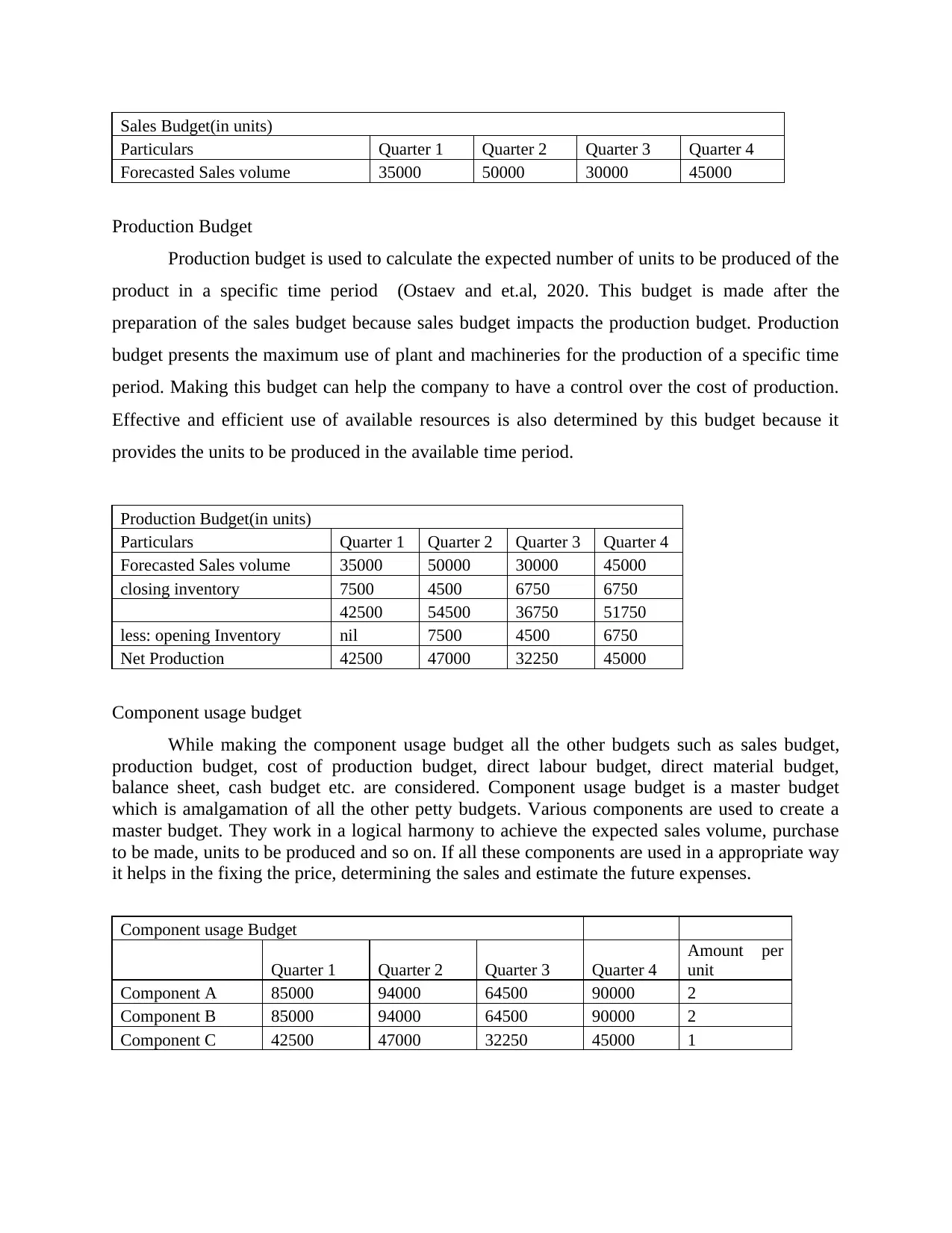
Sales Budget(in units)
Particulars Quarter 1 Quarter 2 Quarter 3 Quarter 4
Forecasted Sales volume 35000 50000 30000 45000
Production Budget
Production budget is used to calculate the expected number of units to be produced of the
product in a specific time period (Ostaev and et.al, 2020. This budget is made after the
preparation of the sales budget because sales budget impacts the production budget. Production
budget presents the maximum use of plant and machineries for the production of a specific time
period. Making this budget can help the company to have a control over the cost of production.
Effective and efficient use of available resources is also determined by this budget because it
provides the units to be produced in the available time period.
Production Budget(in units)
Particulars Quarter 1 Quarter 2 Quarter 3 Quarter 4
Forecasted Sales volume 35000 50000 30000 45000
closing inventory 7500 4500 6750 6750
42500 54500 36750 51750
less: opening Inventory nil 7500 4500 6750
Net Production 42500 47000 32250 45000
Component usage budget
While making the component usage budget all the other budgets such as sales budget,
production budget, cost of production budget, direct labour budget, direct material budget,
balance sheet, cash budget etc. are considered. Component usage budget is a master budget
which is amalgamation of all the other petty budgets. Various components are used to create a
master budget. They work in a logical harmony to achieve the expected sales volume, purchase
to be made, units to be produced and so on. If all these components are used in a appropriate way
it helps in the fixing the price, determining the sales and estimate the future expenses.
Component usage Budget
Quarter 1 Quarter 2 Quarter 3 Quarter 4
Amount per
unit
Component A 85000 94000 64500 90000 2
Component B 85000 94000 64500 90000 2
Component C 42500 47000 32250 45000 1
Particulars Quarter 1 Quarter 2 Quarter 3 Quarter 4
Forecasted Sales volume 35000 50000 30000 45000
Production Budget
Production budget is used to calculate the expected number of units to be produced of the
product in a specific time period (Ostaev and et.al, 2020. This budget is made after the
preparation of the sales budget because sales budget impacts the production budget. Production
budget presents the maximum use of plant and machineries for the production of a specific time
period. Making this budget can help the company to have a control over the cost of production.
Effective and efficient use of available resources is also determined by this budget because it
provides the units to be produced in the available time period.
Production Budget(in units)
Particulars Quarter 1 Quarter 2 Quarter 3 Quarter 4
Forecasted Sales volume 35000 50000 30000 45000
closing inventory 7500 4500 6750 6750
42500 54500 36750 51750
less: opening Inventory nil 7500 4500 6750
Net Production 42500 47000 32250 45000
Component usage budget
While making the component usage budget all the other budgets such as sales budget,
production budget, cost of production budget, direct labour budget, direct material budget,
balance sheet, cash budget etc. are considered. Component usage budget is a master budget
which is amalgamation of all the other petty budgets. Various components are used to create a
master budget. They work in a logical harmony to achieve the expected sales volume, purchase
to be made, units to be produced and so on. If all these components are used in a appropriate way
it helps in the fixing the price, determining the sales and estimate the future expenses.
Component usage Budget
Quarter 1 Quarter 2 Quarter 3 Quarter 4
Amount per
unit
Component A 85000 94000 64500 90000 2
Component B 85000 94000 64500 90000 2
Component C 42500 47000 32250 45000 1
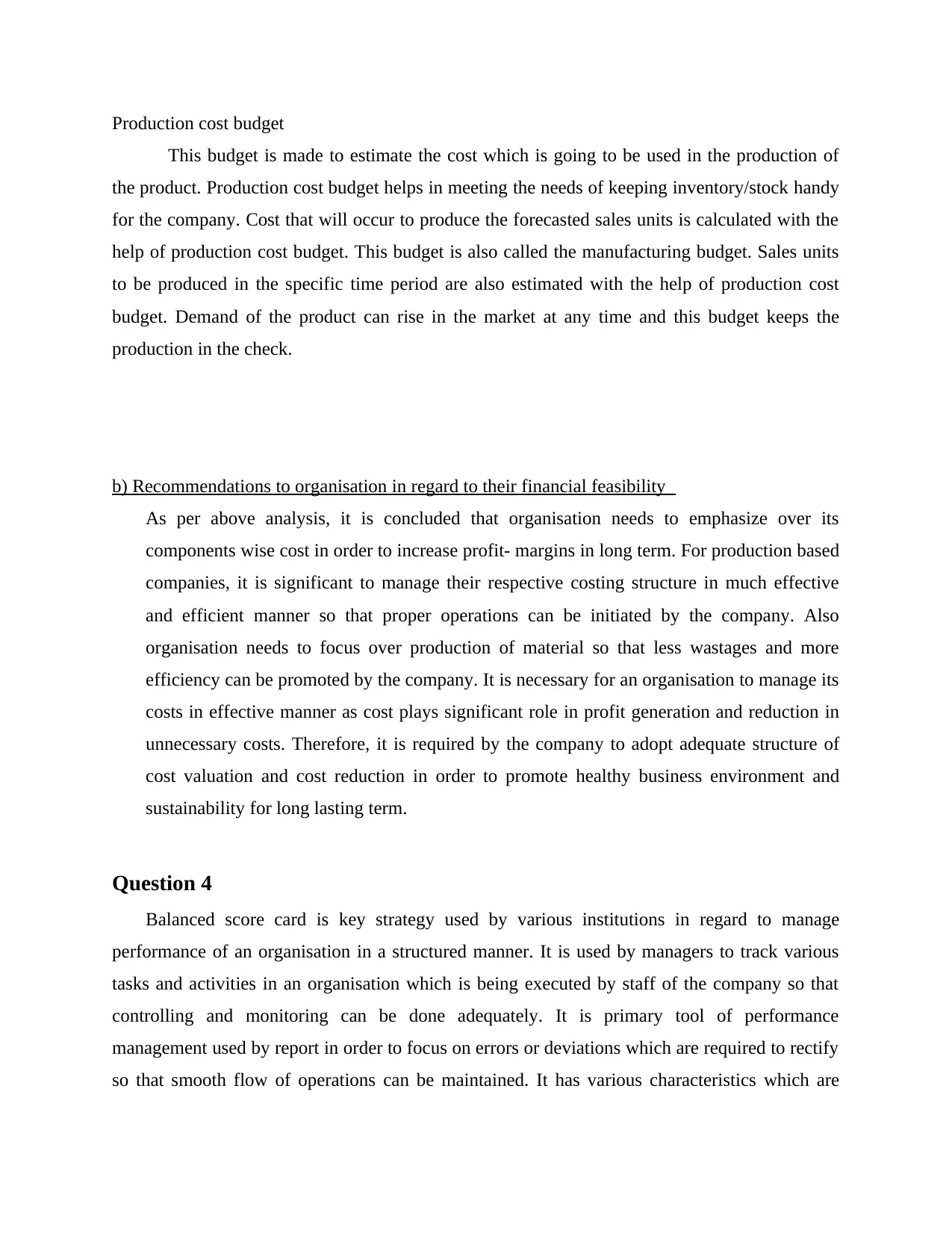
Production cost budget
This budget is made to estimate the cost which is going to be used in the production of
the product. Production cost budget helps in meeting the needs of keeping inventory/stock handy
for the company. Cost that will occur to produce the forecasted sales units is calculated with the
help of production cost budget. This budget is also called the manufacturing budget. Sales units
to be produced in the specific time period are also estimated with the help of production cost
budget. Demand of the product can rise in the market at any time and this budget keeps the
production in the check.
b) Recommendations to organisation in regard to their financial feasibility
As per above analysis, it is concluded that organisation needs to emphasize over its
components wise cost in order to increase profit- margins in long term. For production based
companies, it is significant to manage their respective costing structure in much effective
and efficient manner so that proper operations can be initiated by the company. Also
organisation needs to focus over production of material so that less wastages and more
efficiency can be promoted by the company. It is necessary for an organisation to manage its
costs in effective manner as cost plays significant role in profit generation and reduction in
unnecessary costs. Therefore, it is required by the company to adopt adequate structure of
cost valuation and cost reduction in order to promote healthy business environment and
sustainability for long lasting term.
Question 4
Balanced score card is key strategy used by various institutions in regard to manage
performance of an organisation in a structured manner. It is used by managers to track various
tasks and activities in an organisation which is being executed by staff of the company so that
controlling and monitoring can be done adequately. It is primary tool of performance
management used by report in order to focus on errors or deviations which are required to rectify
so that smooth flow of operations can be maintained. It has various characteristics which are
This budget is made to estimate the cost which is going to be used in the production of
the product. Production cost budget helps in meeting the needs of keeping inventory/stock handy
for the company. Cost that will occur to produce the forecasted sales units is calculated with the
help of production cost budget. This budget is also called the manufacturing budget. Sales units
to be produced in the specific time period are also estimated with the help of production cost
budget. Demand of the product can rise in the market at any time and this budget keeps the
production in the check.
b) Recommendations to organisation in regard to their financial feasibility
As per above analysis, it is concluded that organisation needs to emphasize over its
components wise cost in order to increase profit- margins in long term. For production based
companies, it is significant to manage their respective costing structure in much effective
and efficient manner so that proper operations can be initiated by the company. Also
organisation needs to focus over production of material so that less wastages and more
efficiency can be promoted by the company. It is necessary for an organisation to manage its
costs in effective manner as cost plays significant role in profit generation and reduction in
unnecessary costs. Therefore, it is required by the company to adopt adequate structure of
cost valuation and cost reduction in order to promote healthy business environment and
sustainability for long lasting term.
Question 4
Balanced score card is key strategy used by various institutions in regard to manage
performance of an organisation in a structured manner. It is used by managers to track various
tasks and activities in an organisation which is being executed by staff of the company so that
controlling and monitoring can be done adequately. It is primary tool of performance
management used by report in order to focus on errors or deviations which are required to rectify
so that smooth flow of operations can be maintained. It has various characteristics which are
⊘ This is a preview!⊘
Do you want full access?
Subscribe today to unlock all pages.

Trusted by 1+ million students worldwide
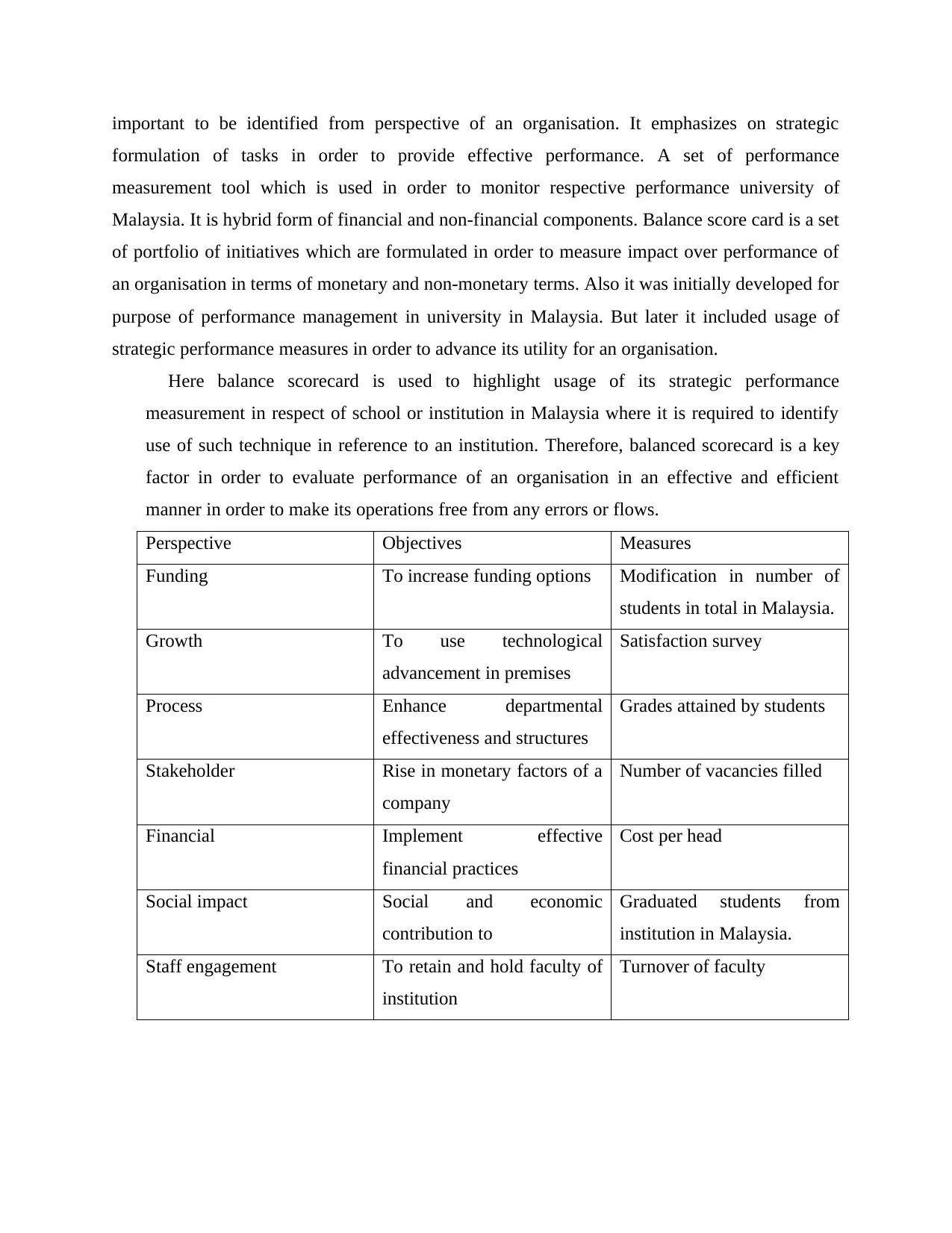
important to be identified from perspective of an organisation. It emphasizes on strategic
formulation of tasks in order to provide effective performance. A set of performance
measurement tool which is used in order to monitor respective performance university of
Malaysia. It is hybrid form of financial and non-financial components. Balance score card is a set
of portfolio of initiatives which are formulated in order to measure impact over performance of
an organisation in terms of monetary and non-monetary terms. Also it was initially developed for
purpose of performance management in university in Malaysia. But later it included usage of
strategic performance measures in order to advance its utility for an organisation.
Here balance scorecard is used to highlight usage of its strategic performance
measurement in respect of school or institution in Malaysia where it is required to identify
use of such technique in reference to an institution. Therefore, balanced scorecard is a key
factor in order to evaluate performance of an organisation in an effective and efficient
manner in order to make its operations free from any errors or flows.
Perspective Objectives Measures
Funding To increase funding options Modification in number of
students in total in Malaysia.
Growth To use technological
advancement in premises
Satisfaction survey
Process Enhance departmental
effectiveness and structures
Grades attained by students
Stakeholder Rise in monetary factors of a
company
Number of vacancies filled
Financial Implement effective
financial practices
Cost per head
Social impact Social and economic
contribution to
Graduated students from
institution in Malaysia.
Staff engagement To retain and hold faculty of
institution
Turnover of faculty
formulation of tasks in order to provide effective performance. A set of performance
measurement tool which is used in order to monitor respective performance university of
Malaysia. It is hybrid form of financial and non-financial components. Balance score card is a set
of portfolio of initiatives which are formulated in order to measure impact over performance of
an organisation in terms of monetary and non-monetary terms. Also it was initially developed for
purpose of performance management in university in Malaysia. But later it included usage of
strategic performance measures in order to advance its utility for an organisation.
Here balance scorecard is used to highlight usage of its strategic performance
measurement in respect of school or institution in Malaysia where it is required to identify
use of such technique in reference to an institution. Therefore, balanced scorecard is a key
factor in order to evaluate performance of an organisation in an effective and efficient
manner in order to make its operations free from any errors or flows.
Perspective Objectives Measures
Funding To increase funding options Modification in number of
students in total in Malaysia.
Growth To use technological
advancement in premises
Satisfaction survey
Process Enhance departmental
effectiveness and structures
Grades attained by students
Stakeholder Rise in monetary factors of a
company
Number of vacancies filled
Financial Implement effective
financial practices
Cost per head
Social impact Social and economic
contribution to
Graduated students from
institution in Malaysia.
Staff engagement To retain and hold faculty of
institution
Turnover of faculty
Paraphrase This Document
Need a fresh take? Get an instant paraphrase of this document with our AI Paraphraser
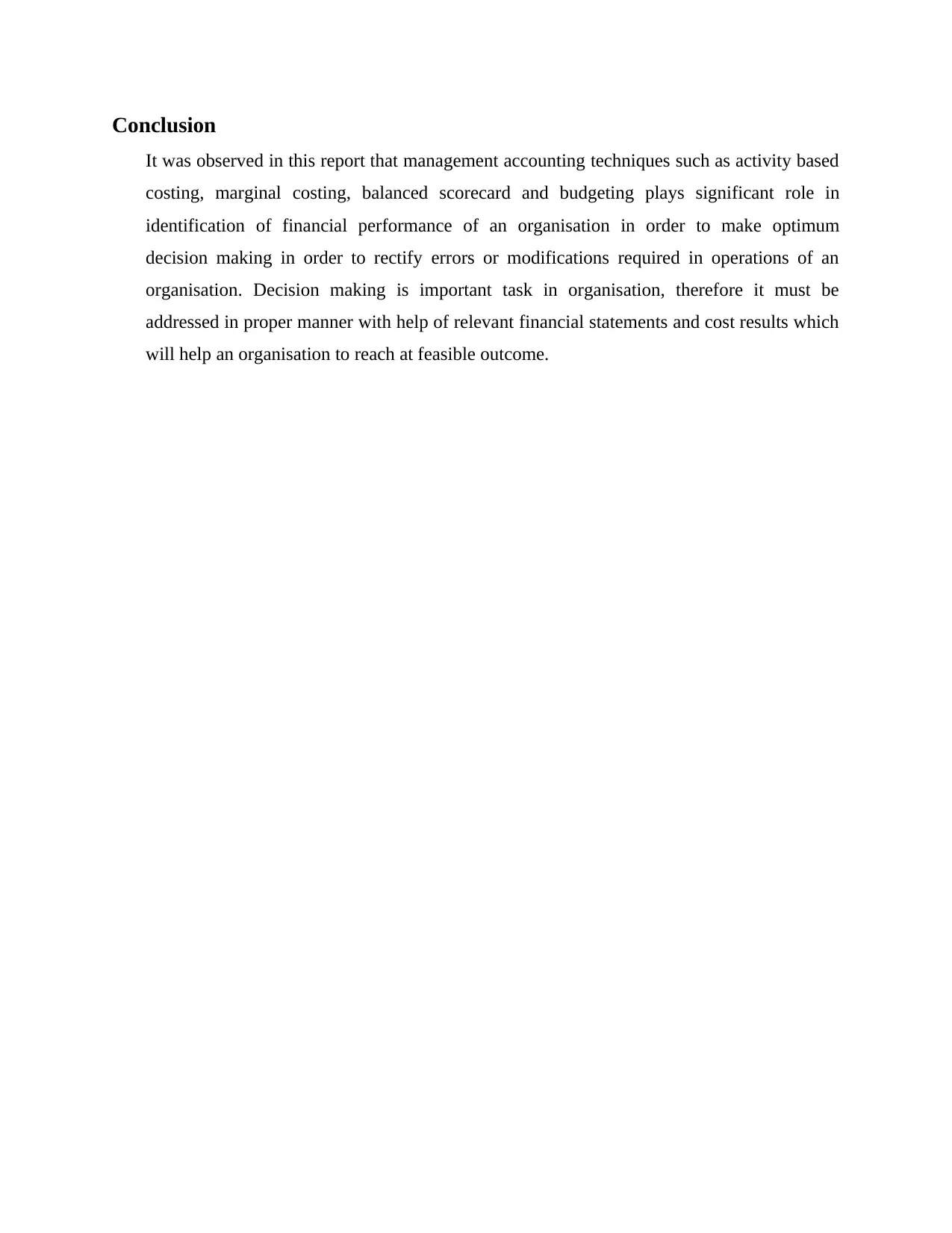
Conclusion
It was observed in this report that management accounting techniques such as activity based
costing, marginal costing, balanced scorecard and budgeting plays significant role in
identification of financial performance of an organisation in order to make optimum
decision making in order to rectify errors or modifications required in operations of an
organisation. Decision making is important task in organisation, therefore it must be
addressed in proper manner with help of relevant financial statements and cost results which
will help an organisation to reach at feasible outcome.
It was observed in this report that management accounting techniques such as activity based
costing, marginal costing, balanced scorecard and budgeting plays significant role in
identification of financial performance of an organisation in order to make optimum
decision making in order to rectify errors or modifications required in operations of an
organisation. Decision making is important task in organisation, therefore it must be
addressed in proper manner with help of relevant financial statements and cost results which
will help an organisation to reach at feasible outcome.
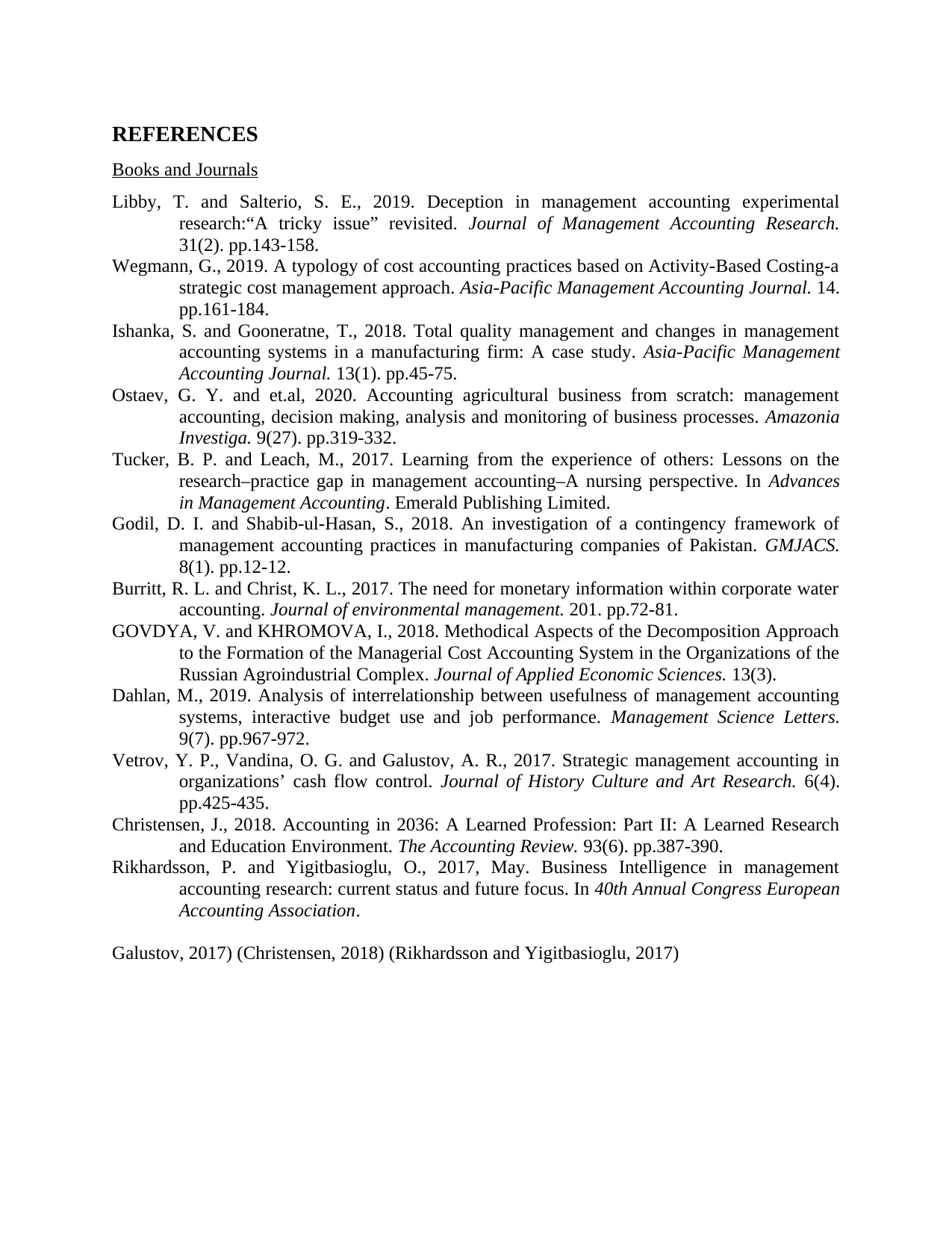
REFERENCES
Books and Journals
Libby, T. and Salterio, S. E., 2019. Deception in management accounting experimental
research:“A tricky issue” revisited. Journal of Management Accounting Research.
31(2). pp.143-158.
Wegmann, G., 2019. A typology of cost accounting practices based on Activity-Based Costing-a
strategic cost management approach. Asia-Pacific Management Accounting Journal. 14.
pp.161-184.
Ishanka, S. and Gooneratne, T., 2018. Total quality management and changes in management
accounting systems in a manufacturing firm: A case study. Asia-Pacific Management
Accounting Journal. 13(1). pp.45-75.
Ostaev, G. Y. and et.al, 2020. Accounting agricultural business from scratch: management
accounting, decision making, analysis and monitoring of business processes. Amazonia
Investiga. 9(27). pp.319-332.
Tucker, B. P. and Leach, M., 2017. Learning from the experience of others: Lessons on the
research–practice gap in management accounting–A nursing perspective. In Advances
in Management Accounting. Emerald Publishing Limited.
Godil, D. I. and Shabib-ul-Hasan, S., 2018. An investigation of a contingency framework of
management accounting practices in manufacturing companies of Pakistan. GMJACS.
8(1). pp.12-12.
Burritt, R. L. and Christ, K. L., 2017. The need for monetary information within corporate water
accounting. Journal of environmental management. 201. pp.72-81.
GOVDYA, V. and KHROMOVA, I., 2018. Methodical Aspects of the Decomposition Approach
to the Formation of the Managerial Cost Accounting System in the Organizations of the
Russian Agroindustrial Complex. Journal of Applied Economic Sciences. 13(3).
Dahlan, M., 2019. Analysis of interrelationship between usefulness of management accounting
systems, interactive budget use and job performance. Management Science Letters.
9(7). pp.967-972.
Vetrov, Y. P., Vandina, O. G. and Galustov, A. R., 2017. Strategic management accounting in
organizations’ cash flow control. Journal of History Culture and Art Research. 6(4).
pp.425-435.
Christensen, J., 2018. Accounting in 2036: A Learned Profession: Part II: A Learned Research
and Education Environment. The Accounting Review. 93(6). pp.387-390.
Rikhardsson, P. and Yigitbasioglu, O., 2017, May. Business Intelligence in management
accounting research: current status and future focus. In 40th Annual Congress European
Accounting Association.
Galustov, 2017) (Christensen, 2018) (Rikhardsson and Yigitbasioglu, 2017)
Books and Journals
Libby, T. and Salterio, S. E., 2019. Deception in management accounting experimental
research:“A tricky issue” revisited. Journal of Management Accounting Research.
31(2). pp.143-158.
Wegmann, G., 2019. A typology of cost accounting practices based on Activity-Based Costing-a
strategic cost management approach. Asia-Pacific Management Accounting Journal. 14.
pp.161-184.
Ishanka, S. and Gooneratne, T., 2018. Total quality management and changes in management
accounting systems in a manufacturing firm: A case study. Asia-Pacific Management
Accounting Journal. 13(1). pp.45-75.
Ostaev, G. Y. and et.al, 2020. Accounting agricultural business from scratch: management
accounting, decision making, analysis and monitoring of business processes. Amazonia
Investiga. 9(27). pp.319-332.
Tucker, B. P. and Leach, M., 2017. Learning from the experience of others: Lessons on the
research–practice gap in management accounting–A nursing perspective. In Advances
in Management Accounting. Emerald Publishing Limited.
Godil, D. I. and Shabib-ul-Hasan, S., 2018. An investigation of a contingency framework of
management accounting practices in manufacturing companies of Pakistan. GMJACS.
8(1). pp.12-12.
Burritt, R. L. and Christ, K. L., 2017. The need for monetary information within corporate water
accounting. Journal of environmental management. 201. pp.72-81.
GOVDYA, V. and KHROMOVA, I., 2018. Methodical Aspects of the Decomposition Approach
to the Formation of the Managerial Cost Accounting System in the Organizations of the
Russian Agroindustrial Complex. Journal of Applied Economic Sciences. 13(3).
Dahlan, M., 2019. Analysis of interrelationship between usefulness of management accounting
systems, interactive budget use and job performance. Management Science Letters.
9(7). pp.967-972.
Vetrov, Y. P., Vandina, O. G. and Galustov, A. R., 2017. Strategic management accounting in
organizations’ cash flow control. Journal of History Culture and Art Research. 6(4).
pp.425-435.
Christensen, J., 2018. Accounting in 2036: A Learned Profession: Part II: A Learned Research
and Education Environment. The Accounting Review. 93(6). pp.387-390.
Rikhardsson, P. and Yigitbasioglu, O., 2017, May. Business Intelligence in management
accounting research: current status and future focus. In 40th Annual Congress European
Accounting Association.
Galustov, 2017) (Christensen, 2018) (Rikhardsson and Yigitbasioglu, 2017)
⊘ This is a preview!⊘
Do you want full access?
Subscribe today to unlock all pages.

Trusted by 1+ million students worldwide
1 out of 13
Related Documents
Your All-in-One AI-Powered Toolkit for Academic Success.
+13062052269
info@desklib.com
Available 24*7 on WhatsApp / Email
![[object Object]](/_next/static/media/star-bottom.7253800d.svg)
Unlock your academic potential
Copyright © 2020–2025 A2Z Services. All Rights Reserved. Developed and managed by ZUCOL.





